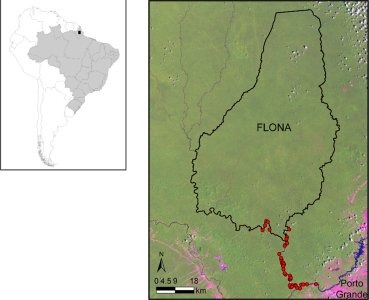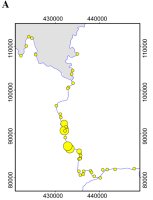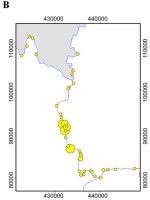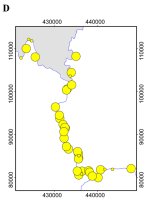IUCN/SSC Otter Specialist Group Bulletin

|
©IUCN/SCC Otter Specialist Group Volume 29 Issue 1 Pages 1 - 67 (January 2012) Citation: Michalski, F., Conceição, P.C., Amador, J.A., Laufer, J. and Norris, D. (2012). Local Perceptions and Implications for Giant Otter (Pteronura brasiliensis) Conservation around Protected Areas in the Eastern Brazilian Amazon. IUCN Otter Spec. Group Bull. 29 (1): 34 - 45 Local Perceptions and Implications for Giant Otter (Pteronura brasiliensis) Conservation around Protected Areas in the Eastern Brazilian Amazon Fernanda Michalski1, 2, 4, Paula C. Conceição1, Joyce A. Amador1, Juliana Laufer1, 2 and Darren Norris1, 3
11Laboratório de Ecologia e Conservação de Vertebrados, Universidade Federal do Amapá, Rod. Juscelino Kubitscheck, km 02, Macapá, AP, 68902-280, Brazil . e-mail:fmichalski@procarnivoros.org.br |



  |
| Received 8th January 2012, accepted 2nd March 2012 |
| Abstract: The local success of protected areas for effective biodiversity conservation depends largely on ensuring the integration of local communities and the persistence of wildlife species and ecological processes. We investigated the perceptions of riverine residents living around a sustainable-use protected area towards giant otters (Pteronura brasiliensis). Between March and December 2011, we conducted 41 interviews with riverine residents in the region of the National Forest of Amapá (AP, Brazil). These interviews revealed a strong negative attitude towards giant otters, highlighted by recent reports of otters being killed in 12.2% of the interviews. Generalized linear models showed that years of education and age weakly predicted attitudes towards otters in the study area (i.e., respondents with the longest time in education and older were less likely to dislike otters and to consider giant otters as damaging income or fishing activities, respectively). These results suggested that to conserve giant otters in this region efforts should focus on environmental education and long-term research projects. |
| Keywords: Brazilian Amazon; Giant otter; human-wildlife conflicts; Pteronura brasiliensis |
| Française | Español |
INTRODUCTION
The rise in the extent of protected areas is a success for global biodiversity conservation (Stokstad, 2010). However, over 86% of all protected areas worldwide permit some form of human use and in the neotropics the prevalence of sustainable-use reserves is greater than in tropical areas of Africa and Asia (Peres, 2011). Currently, almost 37% of the Brazilian Amazon is protected, but in the current protected area system, 22% are indigenous land and 11% are sustainable-use reserves (e.g., production forests) (Azevedo-Ramos et al., 2006). Therefore, the local success of protected areas for effective biodiversity conservation depends largely on ensuring the integration of local communities with activities aimed at conserving wildlife species and ecological processes.
The increase and expansion of human populations means that biodiversity and species conservation activities are intrinsically associated with the socio-economic context (Marshall et al., 2007; Dickman, 2010). The resolution of human-wildlife conflicts (Dickman, 2010), success of re-introduction (Morzillo et al., 2010), and effectiveness of protected areas (Andam et al., 2008) are all dependent on the local context, which includes the perceptions of stakeholders.
Human perceptions towards carnivores differ with a number of variables including: gender (Campbell and Torres Alvarado, 2011), age (Morzillo et al., 2010; Campbell and Torres Alvarado, 2011), species (Lescureux and Linnell, 2010; Campbell and Torres Alvarado, 2011), knowledge/education (Morzillo et al., 2010; Lescureux et al., 2011), location (Dar et al., 2009; Liu et al., 2011), occupation (Hazzah et al., 2009; Lescureux and Linnell, 2010), frequency of contact (Hazzah et al., 2009; Lescureux and Linnell, 2010; Lescureux et al., 2011; Liu et al., 2011), and religious/belief systems (Hazzah et al., 2009; Liu et al., 2011). This lability in perceptions means that through actions such as environmental education it is possible to modify human perceptions, which can directly influence human behaviours with positive outcomes such as reducing human wildlife conflicts and promoting the conservation of biodiversity (Dickman, 2010) but see (Liu et al., 2011).
As found in other carnivore species, human perceptions towards otters differ depending on the socio-economic context. Perceptions may range from positive when otters can act as tourist attractions capable of generating revenue, neutral in agricultural landscapes where they have no impact on local economies (Norris and Michalski, 2009), to negative where giant otters are perceived as competitors by fisherman (Gómez and Jorgenson, 1999; Recharte et al., 2008). Although some studies report correlations between the perceived or real magnitude of damages (e.g. financial losses) and implementation of lethal control measures (Kloskowski, 2011), there is often considerable disparity between the real and perceived impacts of otters (such as net damage and stock consumption) (Gómez and Jorgenson, 1999; Freitas et al., 2007; Recharte et al., 2008; Rosas-Ribeiro et al., 2011; Vaclavikova et al., 2011). Across the Amazon basin, riverine communities struggle to sustain livelihoods. These communities depend on fish as a source of protein and/or financial income. Therefore any real or perceived losses caused by otters will lead to negative impacts on regional conservation efforts. For example damage to even a single fishing net may result not only in injuries to otters but also significant losses for local communities that struggle to sustain livelihoods. As such understanding and resolving otter-human conflicts is vital for both sustainable socio-economic development and biodiversity conservation.
Giant otter populations were decimated throughout their range by the fur trade, for example, 1000–3000 pelts were exported annually from the Brazilian Amazon during the 1950–60’s (Smith, 1980). Additionally, habitat destruction (Michalski and Peres, 2005), and illegal hunting are recognised as principal threats to the remaining giant otter populations (Carter and Rosas, 1997; Duplaix et al., 2008). Due to their piscivorous diet, giant otters are widely perceived as competitors by fisherman across the Amazon basin (Gómez and Jorgenson, 1999; Recharte et al., 2008; Rosas-Ribeiro et al., 2011). Therefore, developing effective mitigation strategies for human-otter conflicts is necessary to prevent local communities in the remaining giant otter strongholds from adopting lethal control in retaliation for perceived and/or real losses. We investigated attitudes of riverine residents towards giant otters in a poorly studied region of the Brazilian Amazon. We evaluated several socio-economic variables in order to determine their influence on local perceptions and to identify possible conflicts between local residents and giant otters.
MATERIAL AND METHODS
Study area
This study was conducted in the region of the National Forest of Amapá (FLONA), Amapá State, eastern Brazilian Amazon (0°55’29’’N, 51°35’45’’W, Fig. 1). FLONA is a 412,000 ha sustainable-use reserve, adjacent to continuous undisturbed forest areas and maintains the full community of medium and large bodied vertebrates. This protected area experiences low levels of anthropogenic perturbations, in part because only eight families live on the reserve border, and the nearest city (Porto Grande) is located 46 km by river from the area (Fig. 1).
Data collection
From March to December 2011 we used pre-elaborated questionnaires to interview all local riverine residents along the Araguari and Falsino Rivers from Porto Grande municipality to the nearest protected area (FLONA; Fig. 1). The interviews were conducted on a one to one basis with researchers asking questions and taking notes of the responses.
As a key prerequisite, all riverine residences that we visited were associated with one local informant (long-term resident and or landowner), who was (1) willing to be interviewed, (2) had local information regarding the study area and fishing practices, (3) had knowledge of the local wild fauna, and (4) had been living in the property or close to it for at least one year (mean ± SD = 16.1 ± 13.5 years, range = 1.5 – 51 years; n = 41 respondents). To understand attitudes towards giant otters we focused on replies to six questions (i.e., response variables):
- List five wild animal species they liked, with species ranked according to the order in which they were mentioned (e.g. first mentioned species was the most liked);
- List five wild animal species that they disliked, with species ranked according to the order in which they were mentioned (e.g. first mentioned species was the most disliked);
- Which five wild animal species damage family income, with species ranked according to the order in which they were mentioned (e.g. first mentioned species was the most damaging to income);
- Which five wild animal species damage (directly or indirectly) fishing activity, with species ranked according to the order in which they were mentioned (e.g. first mentioned species was the most damaging);
- Whether they had experienced a problem with giant otters (e.g., ripped fishing net) in the past five years, recorded as a single yes or no answer;
- Whether giant otters had been killed in the region close to their house in the past five years, recorded as a single yes or no answer.
Our pre-elaborated questionnaires were also used to obtain information from the respondent, such as age, years of school education, and the principal source of income, all of which can influence perceptions towards giant otters (i.e., predictor variables).
Data analysis
All analyses were performed in R (R Development Core Team, 2010). To examine if the protected area influenced respondents perceptions towards giant otters we compared responses between i) two classes: within and outside of the protected area and ii) between three classes representing three zones delineated based on proximity to the protected area (near: up to 3 km, intermediate: from 8 to 25 km, and far: from 27 to 43 km). Responses to all six questions were transformed to a binary (yes or no) variable. For example all respondents who mentioned giant otters as one of the disliked species were “yes” and those who did not “no”. We then compared the proportion of respondents who replied yes between the classes (protected area and proximity) using the R function “prop.test”, which tests the null that the proportions (probabilities of success) in several groups are the same.
We used generalized linear models (GLMs – family = binomial, link=logit) to investigate predictors of the perceptions of riverine residents towards giant otters. Perceptions towards giant otters were defined by four responses: “Dislike” (binary response of whether respondents mentioned giant otter as a disliked animal), “Problem” (binary response of whether respondents had ever encountered a problem with giant otters such as damage to fishing nets), “Damage income” (binary response of whether respondents mentioned giant otters as damaging the family income), “Damage fish” (binary response of whether respondents mentioned giant otters as species that damaged fishing activities).
As predictors of interviewee responses we used age (as a continuous variable), the years of school education (split into three classes: illiterate, one to five years, and six to ten years of schooling), distance to FLONA (measured from the Landsat image by following the river channel from the residence to the southeast border of the protected area for all interviews conducted outside FLONA and labelled as zero for all residences located on the border of the protected area), and the principal source of income of the interviewee (three classes: agriculture, fishing, and other). The influence of these predictors on the response variables was tested with separate GLMs to understand how these predictors could affect the perceptions towards giant otters. We adopted a backwards stepwise selection (R function “step”) applying the program defaults to arrive at a most parsimonious (i.e. “best”) model. We compared variable slope estimates in both the full and the “best” model selected, which enables us to avoid well known issues of stepwise approaches (e.g., inflated Type 1 error rates) (Mundry and Nunn, 2009).
RESULTS
We conducted 41 interviews with riverine residents located along the Araguari and Falsino Rivers (Fig. 1). The Euclidian nearest neighbour distance between all interviews was on average 13.4 km (± SD = 9.2 km, range = 0.1-38.4 km, n=820 pairwise comparisons). The principal source of income for the majority of respondents was from agriculture (68.3%, n=28), followed by fishing (21.9%, n=9). Although the majority did not necessarily depend financially on fishing, all respondents went fishing frequently (i.e. at least monthly), with the majority (53.6%, n=22) fishing daily. Fish was an important food item, with all families eating at least 250 grams of fish per week and the majority (80.4%, n = 33) consuming more than 2 kg of fish per week.
None of the interviewees cited giant otters as a “Liked” species, with responses generally neutral i.e. 87.8% (n = 36) interviewees did not mention giant otters as a “Liked” or “Disliked” species. However, considering responses to all questions asked (Table 1) there were clearly strong negative perceptions towards giant otters throughout the region (Fig. 2). The majority of respondents identified giant otters as a species that “caused problems” (e.g. ripped fishing nets) and “damaged fishing activities” (73.2 and 75.6% respectively). When questioned about the top five animals that most damage monthly family income giant otters were cited by six respondents (14.6%) and not mentioned by the remaining 35 residents (85.4%) (Table 1; Fig. 2B).
When asked if interviewees had ever killed giant otters in the past five years in the study area, five (12.2%) confirmed that giant otters had been killed (Table 1) as a result of fear (n=2), anger or simple retaliation during fishing activities (n=3). Although interviewees did not provide exact dates of when the giant otters were killed, the most recent report was one year before our interview. These reports occurred throughout all the classes of proximity from FLONA (n=1, 3, 1, near, intermediate, and far, respectively).
Visual inspection revealed that negative perceptions of giant otters as a problem species (Fig. 2D) and a species that damaged fishing activities (Fig. 2C) occurred throughout the region. However, perceptions of dislike (Fig. 2A) and damaging income (Fig. 2B) were clustered within a 15.8 km stretch of river (“intermediate zone”) between the town of Porto Grande and FLONA. Although residents bordering the protected area tended to have less negative perceptions towards giant otters (Table 1) when compared with those living outside, this difference in perceptions was not significant. However, responses did differ significantly between residents when classified into the three “proximity” zones. Respondents living at intermediate distances from the protected area were generally most frequently negative in their perceptions of giant otters (Table 1) and a greater proportion (27.8%) cited giant otters as a “Disliked” species and one that “Damaged income” (33.3%). However, the proportions of negative responses of interviewees living near to and far from the protected area were very similar (Table 1).
Our GLMs showed that perceptions towards giant otters were hard to predict. Our four predictors were most adequate when used to model when respondents disliked giant otters, however they explained only 28.8 % of this model deviance and the most parsimonious model which retained “Education” (where respondents with the longest time in education were less likely to dislike giant otters) was only marginally significant (P=0.054) (Table 2). The most parsimonious models predicting whether respondents considered that giant otters damaged income and fishing activities both retained only age, with older respondents less likely to consider giant otters as damaging income or fishing activities (deviance explained 8.3 and 4.6% damage income and fishing respectively), however neither model was statistically significant (P=0.093 and P=0.146, damage income and fishing activity respectively) (Table 2).
DISCUSSION
As far as we are aware this study is the first to quantify perceptions of riverine residents towards giant otters in the eastern Brazilian Amazon. Our findings show that giant otters are (1) negatively perceived throughout the study region, (2) more positively perceived by respondents with the longest time in education, (3) less likely to be considered as damaging income or fishing activities by older respondents, and (4) have been killed recently in the area. Our findings reinforce the importance of studies with human-wildlife conflicts in and around sustainable-use reserves in the Brazilian Amazon, in order to ensure the long-term persistence of endangered species.
Conflicts between Amazon fishermen and giant otters have been reported from Colombia (Gómez and Jorgenson, 1999), Peru (Recharte et al., 2008), and Brazil (Rosas-Ribeiro et al., 2011). The primary reason for these conflicts was the overlap in space and time of resource use between humans and giant otters. Fish is an important food resource among Amazonian riverside people (Boischio and Henshel, 2000; Dorea, 2003), and riverine communities have been heavy consumers of fish due to their plentiful availability, and difficulties of acquiring alternative protein sources (e.g., via raising cattle) (Hiraoka, 1992). Similarly, in our study region, all respondents went fishing frequently (at least monthly), with 80% of the people interviewed consuming more than 2 kg of fish per week. This dependence on fish is very similar with that of the giant otter, which are primarily piscivorous and can eat up to 10% of their body weight per day (Duplaix, 1980; Rosas et al., 1999). Therefore, it is not surprising that giant otters are negatively perceived throughout our study region, and that 76% of respondents perceive otters as damaging fishing activities.
Despite well documented fishermen-giant otter conflicts (Duplaix, 1980; Bisbal, 1993; Gómez and Jorgenson, 1999; Recharte et al., 2008; Rosas-Ribeiro et al., 2011) there are no studies reporting socio-economic (such as education level and age) influences on perceptions towards giant otters in riverine communities. Although inference from our sample of 41 riverine residents is limited, the sample included all permanent residents in and around FLONA. As such, our results present a complete representation of the riverine population in the study area.
Our results suggested that older respondents and those with the longest time in education were less likely to dislike otters and to consider giant otters as damaging income or fishing activities. However, these variables were not strong predictors of perceptions in our analyses. We believe that this is partly explained by the profile of the respondents who were in general very similar (i.e., all male, principal income generators, and frequent fishers). These similarities mean that we would not expect to find strong differences in perceptions towards giant otters in the study area. The most surprising result was the widespread negative perceptions and the intensity of kills of giant otters. Based on our interview data, we found that a minimum of 0.6 giant otters per 10 km of river had been killed in the past five years in a relatively short river stretch (ca. 86.1 km).
For a long lived species such as giant otters (Carter and Rosas, 1997) with a complex social structure (Duplaix, 1980; Davenport, 2010), human induced mortalities may strongly influence (both directly and indirectly) the long-term persistence of the species in the area. In an area of the Peruvian Amazon where the giant otter population was increasing, hunters and fishermen rarely hunted the species due to limited markets and/or uses (Recharte Uscamaita and Bodmer, 2010). In our study area, we have no published historical or recent data on the giant otter population. Thus, further studies must be conducted in order to evaluate if the giant otter population is increasing, stable or decreasing and the potential impact of the kills around the protected area.
Previous studies have demonstrated that inappropriately managed tourism can threaten giant otter populations within protected areas (Schenck and Staib, 1992). Tourism does not occur in our study area and our results suggested that the activities of local residents within and around the protected area (FLONA) are the major threats to giant otter populations. Proximity to the protected area did not strongly influence perceptions towards giant otters in the study area. Additionally, reported kills of giant otters were also widely distributed. Although the protected area does not appear to influence negatively the perceptions towards giant otters, it is also not increasing the positive answers of the interviewees.
The protected area (FLONA) is a sustainable-use reserve, which is supposed to be sustainable for both people and wildlife species. Considering the regional socio-economic context (all riverine residents have a low income and, in general, low education level), a positive management action for FLONA would be a closer engagement with the human population particularly to encourage and support the adoption of sustainable activities (e.g., extraction of non-timber products) within and around FLONA. If such activities were coupled with environmental education we believe that a truly sustainable co-existence between local community and giant otters could be achieved.
More standardized studies that apply detailed questionnaires are needed throughout the species range. For example based on questions involving lists of most liked and disliked animals in another study region in the Brazilian Amazon, Norris and Michalski (2009), found that landowners had neutral attitudes towards giant otters. However, here we showed that the simple question generating a list of animals that were liked and disliked on its own is not sufficient to assess perceptions. Although we believe that conclusions from Norris and Michalski (2009) are valid as landowners in the same region never cited giant otters as a species that damaged income in a larger set of interviews (n=236, Michalski et al., 2006), future studies should adopt more detailed questions such as those presented here.
With the expansion of human settlements across the Amazon, our conclusions highlight the importance of detailed studies that could provide information in order to focus conservation efforts in areas with potential human-otter conflicts. This detailed information is required to inform the development and application of environmental education activities and facilitate the sustainable development of livelihoods and local communities within and around the expanding network of sustainable-use reserves.
Acknowledgements - This research was supported by Conservation International - Brazil, and the Walmart Institute – Brazil through the project “Support to the implementation of the Amapá National Forest”, and The Rufford Small Grants for Nature Conservation. Instituto Chico Mendes de Conservação da Biodiversidade (ICMBIO) and the Universidade Federal do Amapá provided logistical support. PCC and JAA were funded by a National Council for Scientific and Technological Development (CNPq) PIBIC studentships, JL was funded by a Brazilian Ministry of Education (CAPES) PhD studentship, and DN was funded by a CNPq PhD studentship. We are deeply indebted to the riverine residents that contributed to this study and to Alvino Pantoja and Dinael Soares for field assistance. This article resulted from the PPBio/CENBAM Workshop conducted by William Magnusson.
REFERENCES
Andam, K.S., Ferraro, P.J., Pfaff, A., Sanchez-Azofeifa, G.A., Robalino, J.A. (2008). Measuring the effectiveness of protected area networks in reducing deforestation. Proceedings of the National Academy of Sciences of the United States of America, 105: 16089-16094.
Azevedo-Ramos, C., do Amaral, B.D., Nepstad, D.C., Soares Filho, B., Nasi, R. (2006). Integrating ecosystem management, protected areas, and mammal conservation in the Brazilian Amazon. Ecology and Society, 11.
Bisbal, F.J. (1993). Human impact on the carnivores of Venezuela. Studies on Neotropical Fauna and Environment, 28: 145-156.
Boischio, A.A.P., Henshel, D. (2000). Fish consumption, fish lore, and mercury pollution - Risk communication for the Madeira river people. Environmental Research Section A, 84: 108-126.
Campbell, M.O.N., Torres Alvarado, M.E. (2011). Public perceptions of jaguars Panthera onca, pumas Puma concolor and coyotes Canis latrans in El Salvador. Area, 43: 250-256.
Carter, S.K., Rosas, F.C.W. (1997). Biology and conservation of the giant otter Pteronura brasiliensis. Mammal Review, 27: 1-26.
Dar, N.I., Minhas, R.A., Zaman, Q., Linkie, M. (2009). Predicting the patterns, perceptions and causes of human-carnivore conflict in and around Machiara National Park, Pakistan. Biological Conservation, 142: 2076-2082.
Davenport, L.C. (2010). Aid to a Declining Matriarch in the Giant Otter (Pteronura brasiliensis). Plos One, 5. [http://www.plosone.org/article/info%3Adoi%2F10.1371%2Fjournal.pone.0011385 Accessed 1 June 2012]
Dickman, A.J. (2010). Complexities of conflict: the importance of considering social factors for effectively resolving human-wildlife conflict. Animal Conservation, 13: 458-466.
Dorea, J.G. (2003). Fish are central in the diet of Amazonian riparians: should we worry about their mercury concentrations? Environmental Research, 92: 232-244.
Duplaix, N. (1980). Observations on the ecology and behavior of the giant river otter Pteronura brasiliensis in Suriname. Terre Et La Vie-Revue D'Ecologie Appliquee, 34: 495-620.
Duplaix, N., Waldemarin, H.F., Groenedijk, J., Evangelista, E., Munis, M., Valesco, M., Botello, J.C. (2008). In IUCN 2011. IUCN Red List of Threatened Species. Version 2011.2.
Freitas, D., Gomes, J., Luis, T.S., Madruga, L., Marques, C., Baptista, G., Rosalino, L.M., Antunes, P., Santos, R., Santos-Reis, M. (2007). Otters and fish farms in the Sado estuary: ecological and socio-economic basis of a conflict. Hydrobiologia, 587: 51-62.
Gómez, J.R., Jorgenson, J.P. (1999). An overview of the giant otter-fisherman problem in the Orinoco Basin of Colombia. IUCN Otter Specialist Group Bulletin, 16: 90 - 96.
Hazzah, L., Mulder, M.B., Frank, L. (2009). Lions and warriors: social factors underlying declining African lion populations and the effect of incentive-based management in Kenya. Biological Conservation, 142: 2428-2437.
Hiraoka, M. (1992). Caboclo and ribereño resource management in Amazonia: a review. In K.H. Redford and C. Padoch(eds):Conservation of Neotropical Forests Columbia University Press, New York.
Kloskowski, J. (2011). Human-wildlife conflicts at pond fisheries in eastern Poland: perceptions and management of wildlife damage. European Journal of Wildlife Research, 57: 295-304.
Lescureux, N., Linnell, J.D.C. (2010). Knowledge and Perceptions of Macedonian Hunters and Herders: The Influence of Species Specific Ecology of Bears, Wolves, and Lynx. Human Ecology, 38: 389-399.
Lescureux, N., Linnell, J.D.C., Mustafa, S., Melovski, D., Stojanov, A., Ivanov, G., Avukatov, V., von Arx, M., Breitenmoser, U. (2011). Fear of the unknown: local knowledge and perceptions of the Eurasian lynx Lynx lynx in western Macedonia. Oryx, 45: 600-607.
Liu, F., McShea, W.J., Garshelis, D.L., Zhu, X., Wang, D., Shao, L. (2011). Human-wildlife conflicts influence attitudes but not necessarily behaviors: Factors driving the poaching of bears in China. Biological Conservation, 144: 538-547.
Marshall, K., White, R., Anke, F. (2007). Conflicts between humans over wildlife management: on the diversity of stakeholder attitudes and implications for conflict management. Biodiversity and Conservation, 16: 3129-3146.
Michalski, F., Boulhosa, R.L.P., Faria, A., Peres, C.A. (2006). Human-wildlife conflicts in a fragmented Amazonian forest landscape: determinants of large felid depredation on livestock. Animal Conservation, 9: 179-188.
Michalski, F., Peres, C.A. (2005). Anthropogenic determinants of primate and carnivore local extinctions in a fragmented forest landscape of southern Amazonia. Biological Conservation, 124: 383-396.
Morzillo, A.T., Mertig, A.G., Hollister, J.W., Garner, N., Liu, J. (2010). Socioeconomic factors affecting local support for black bear recovery strategies. Environmental Management, 45: 1299-1311.
Mundry, R., Nunn, C.L. (2009). Stepwise model fitting and statistical inference: turning noise into signal pollution. American Naturalist, 173: 119-123.
Norris, D., Michalski, F. (2009). Are otters an effective flagship for the conservation of riparian cCorridors in an Amazon Deforestation Frontier? IUCN Otter Specialist Group Bulletin, 26: 73-77.
Peres, C.A. (2011). Conservation in sustainable-use tropical forest reserves. Conservation Biology, 25: 1124-1129.
R Development Core Team (2010). R Foundation for Statistical Computing, Vienna, R Foundation for Statistical Computing, ISBN 3-900051-07-0.
Recharte, M., Bowler, M., Bodmer, R. (2008). Potential conflict between fishermen and giant otter (Pteronura brasiliensis) populations by fishermen in response to declining stocks of Arowana fish (Osteoglossum bicirrhosum) in Northeastern Peru. IUCN Otter Specialist Group Bulletin, 25: 89 - 93.
Recharte Uscamaita, M., Bodmer, R. (2010). Recovery of the Endangered giant otter Pteronura brasiliensis on the Yavari-Mirin and Yavari Rivers: a success story for CITES. Oryx, 44: 83-88.
Rosas-Ribeiro, P.F., Rosas, F.C.W., Zuanon, J. (2011). Conflict between fishermen and giant otters Pteronura brasiliensis in Western Brazilian Amazon. Biotropica, DOI: 10.1111/j.1744-7429.2011.00828.x.
Rosas, F.C.W., Zuanon, J.A.S., Carter, S.K. (1999). Feeding ecology of the giant otter, Pteronura brasiliensis. Biotropica, 31: 502-506.
Schenck, C. and Staib, E. (1992). Giant otters in Peru. IUCN Otter Specialist Group Bulletin, 7: 24-26.
Smith, N.J.H. (1980) Caimans, capybaras, otters, manatees, and man in Amazonas. Biological Conservation, 19: 177–187.
Stokstad, E. (2010). Despite progress, biodiversity declines. Science, 329: 1272-1273.
Vaclavikova, M., Vaclavik, T., Kostkan, V. (2011). Otters vs. fishermen: Stakeholders' perceptions of otter predation and damage compensation in the Czech Republic. Journal for Nature Conservation, 19: 95-102.
Résumé : Perceptions et Implications Locales pour la Conservation de la Loutre Géante (Ptenonura brasiliensis) autour d’Aires Protégées Brésiliennes de l’Est de l’Amazone
Le succès des aires protégées pour la conservation de la biodiversité dépend en grande partie de l'intégration des communautés locales et de la persistance d’espèces sauvages et de processus écologiques. Nous avons étudié les perceptions de résidents riverains d'une zone protégée pour les loutres géantes (Pteronura brasiliensis). Entre Mars et Décembre 2011, nous avons mené 41 interviews dans la région de la Forêt Nationale de l'Amapá (AP, Brésil). Ces dernières ont révélé une forte attitude négative à l'égard des loutres géantes, soutenu par le rapport de loutres tuées dans 12,2% des conversations. Les modèles linéaires généralisés ont montré que des années d’éducation et l'âge des personnes concernées limitent les attitudes néfastes envers la Loutre dans la zone d'étude (les personnes sondées ayant une éducation avancée et plus âgées étaient moins susceptibles de ne pas aimer les loutres et d'envisager des loutres géantes comme non préjudiciables pour leurs revenus ou pour les activités de pêche). Ces résultats suggèrent que pour conserver des loutres géantes dans cette région, les efforts devraient se concentrer sur l'éducation environnementale et les projets de recherche à long terme.
Revenez au dessus
Resumen: Percepciones Locales e Implicaciones para la Conservacion del Lobo de Rio (Pteronura brasiliensis) alrededor de Áreas Protegidas en la Amazonia Oriental del Brasil
El éxito local de áreas protegidas para la conservación de la biodiversidad depende en gran parte en asegurar la integración de comunidades locales y la persistencia de la vida silvestre y procesos ecológicos. Investigamos percepciones de gente local viviendo alrededor de un área protegida de uso-sostenible hacia el lobo de río (Pteronura brasiliensis). Entre Marzo y Noviembre 2011, llevamos a cabo 41 entrevistas con los residentes ribereños de la región del Bosque Nacional de Amapá (AP, Brasil). Estas entrevistas revelaron una fuerte actitud negativa hacia el Lobo de Río, resaltado por los informes recientes que nutrias fueron asesinadas en un 12,2% de las entrevistas. Modelos lineales generalizados mostró que los años de la educación y la edad predice débilmente las actitudes hacia las nutrias en la zona de estudio (es decir, los encuestados con más tiempo en la educación y los mayores de edad eran menos propensos a rechazar las nutrias y considerar a lobos de río como perjudicial a sus ingresos o las actividades de pesca, respectivamente). Estos resultados sugieren que para conservar el lobo de río en la región se debe enfocar en la educación ambiental y proyectos de investigación a largo plazo.
Vuelva a la tapa




